Tuesday, 23 February 2010
Thursday, 22 October 2009
Evaluation of 8 Shot Journey
Evaluation
For the 8 shot journey we had to make a simple but creative short film that was made up of 8 shot’s, we also had to keep it in mainly one setting or different settings that where similar to one another. Our character had to end up at a destination and not to be just walking around anywhere. Their also had to be a range of shots, that where of different sizes and of different angles.
Looking at the filming of my 8 shot journey I felt that it was fairly good as I didn’t have to do many takes, part of this was because I used people who were in the shot that weren’t meant to be as foreground and had my character as middle ground. I however found that it was hard to get the right space for my camera to stand properly also there was some technical problems with the lift as it took very long to come and other people where in the lift when filming so I had to make sure that no-one but my actor was in shot.
For this project I had two people helping me with different roles the first was Luke Hindle, he was my actor I felt he was very good just needed to concentrate a bit more, his role was to follow my instructions of what I told him to do on camera. The second role was of mark Clowe, he was my location manager his role was to make sure people didn’t do anything silly in front of the camera and to set up the camera for me and say whether the shot matched the story board.
After shooting the 8 shot journeys I went to edit it, the software I used was final cut pro, this is fairly easy software to use it is very basic but also very advanced than your normal editing software’s. the only hard and long bit was actually putting it onto the computer as it took a long while to log the shot’s and get the right places however the log sheet did help to make it a little bit faster. The actual editing of the production was easy as most of the shot’s were filmed in order however I had to replace the second shot as the one that I thought was ok was actually to fast so I had to get a bogus shot that I didn’t want to use and put it in the other shots place. I also found that the sequence of scenes didn’t flow alto so I had to put in fades to make it look like time had past. Over all I found this project to go very well and I am happy with my overall finished version one thing I may have changed was the actor and making sure that I made flow better so I didn’t have to put in the fades.
For the 8 shot journey we had to make a simple but creative short film that was made up of 8 shot’s, we also had to keep it in mainly one setting or different settings that where similar to one another. Our character had to end up at a destination and not to be just walking around anywhere. Their also had to be a range of shots, that where of different sizes and of different angles.
Looking at the filming of my 8 shot journey I felt that it was fairly good as I didn’t have to do many takes, part of this was because I used people who were in the shot that weren’t meant to be as foreground and had my character as middle ground. I however found that it was hard to get the right space for my camera to stand properly also there was some technical problems with the lift as it took very long to come and other people where in the lift when filming so I had to make sure that no-one but my actor was in shot.
For this project I had two people helping me with different roles the first was Luke Hindle, he was my actor I felt he was very good just needed to concentrate a bit more, his role was to follow my instructions of what I told him to do on camera. The second role was of mark Clowe, he was my location manager his role was to make sure people didn’t do anything silly in front of the camera and to set up the camera for me and say whether the shot matched the story board.
After shooting the 8 shot journeys I went to edit it, the software I used was final cut pro, this is fairly easy software to use it is very basic but also very advanced than your normal editing software’s. the only hard and long bit was actually putting it onto the computer as it took a long while to log the shot’s and get the right places however the log sheet did help to make it a little bit faster. The actual editing of the production was easy as most of the shot’s were filmed in order however I had to replace the second shot as the one that I thought was ok was actually to fast so I had to get a bogus shot that I didn’t want to use and put it in the other shots place. I also found that the sequence of scenes didn’t flow alto so I had to put in fades to make it look like time had past. Over all I found this project to go very well and I am happy with my overall finished version one thing I may have changed was the actor and making sure that I made flow better so I didn’t have to put in the fades.
Wednesday, 21 October 2009
8 Shot Journey
8 Shot Journey
For productions of films there are 3 main parts to the production process.
The first is pre-production:- at this stage of production you have to get the things to help you shot your production, these are story boards, finding the location, gathering props and creating the script for your production.
The actual production: - this is when you use all your pre-production resources. This is when you get footage for editing so this is shooting your production, recording the sound and just generally gathering all recourses that you need to piece together your production in editing.
Post-production (project in post):- this is getting the project to the final stage and getting the finished version, this is editing the project and part of this is transferring the clips of footage on to computer, this can be a very long and tiring process, then the final thing to do in this process is evaluating the work.
Cinematography laws
&
Do’s and don’ts
The way that a film is made up is fairly complex, but the best way to describe how to build up a film is by describing it like an essay, this is the scale that it goes in: - frames are a letter, shots are a word, sequences are a sentence, scenes are a paragraph and movies/programs are an essay.
Here are the definitions of what different parts of a film reel are:-
Frame is a single cell of a film reel.
A shot is a continues strip of motion picture film, created by a series of frames, that runs for an uninterrupted period of time.
A scene is part of the action that happens in one location and changes when the location changes.
A sequence is a series of scenes that flow together into each other.
A movie or program is the whole body or all the scenes put together.
Shot sizes
Shot sizes can range from extreme close up to a very long shot .different shot’s are good for establishing shots to get the correct shot that you want and want to create. to determine what size of shot you need, you have to decide what the viewer would want to see. for the viewer to have your ideas established to them you should show a lot and leave the shot for a while to give the viewer more information about the scene, a close up is used to show things about a person or character.
Composition: Rule of 1/3rds
For this rule a lot of objects are placed to the side of the scene rather than a centred shot to give the character or moving image room or space to move into. To make more sense of this people often draw a norts and crosses grid in their head, the top line across should be in the eye line of the person or character; this makes the shot look better and more creative. The bottom line of this is usually the horizon line, so this is where the sky and the land meet often but not all the time. The vertical lines are often where action is placed around or in the middle of. Here is an example of the grid
For productions of films there are 3 main parts to the production process.
The first is pre-production:- at this stage of production you have to get the things to help you shot your production, these are story boards, finding the location, gathering props and creating the script for your production.
The actual production: - this is when you use all your pre-production resources. This is when you get footage for editing so this is shooting your production, recording the sound and just generally gathering all recourses that you need to piece together your production in editing.
Post-production (project in post):- this is getting the project to the final stage and getting the finished version, this is editing the project and part of this is transferring the clips of footage on to computer, this can be a very long and tiring process, then the final thing to do in this process is evaluating the work.
Cinematography laws
&
Do’s and don’ts
The way that a film is made up is fairly complex, but the best way to describe how to build up a film is by describing it like an essay, this is the scale that it goes in: - frames are a letter, shots are a word, sequences are a sentence, scenes are a paragraph and movies/programs are an essay.
Here are the definitions of what different parts of a film reel are:-
Frame is a single cell of a film reel.
A shot is a continues strip of motion picture film, created by a series of frames, that runs for an uninterrupted period of time.
A scene is part of the action that happens in one location and changes when the location changes.
A sequence is a series of scenes that flow together into each other.
A movie or program is the whole body or all the scenes put together.
Shot sizes
Shot sizes can range from extreme close up to a very long shot .different shot’s are good for establishing shots to get the correct shot that you want and want to create. to determine what size of shot you need, you have to decide what the viewer would want to see. for the viewer to have your ideas established to them you should show a lot and leave the shot for a while to give the viewer more information about the scene, a close up is used to show things about a person or character.
Composition: Rule of 1/3rds
For this rule a lot of objects are placed to the side of the scene rather than a centred shot to give the character or moving image room or space to move into. To make more sense of this people often draw a norts and crosses grid in their head, the top line across should be in the eye line of the person or character; this makes the shot look better and more creative. The bottom line of this is usually the horizon line, so this is where the sky and the land meet often but not all the time. The vertical lines are often where action is placed around or in the middle of. Here is an example of the grid
180 Degree Line Rule
This is an imaginary line that you often put through your shot. You can only one side of the line not both sides of the line. This is because it can stop the character going in one direction and confuse the viewers and make the sequence look wrong and not flowing. However you can break this rule by moving the camera over the line but you have to show the viewer that you are moving across the line so it will make sense, here is a diagram to show this
This is an imaginary line that you often put through your shot. You can only one side of the line not both sides of the line. This is because it can stop the character going in one direction and confuse the viewers and make the sequence look wrong and not flowing. However you can break this rule by moving the camera over the line but you have to show the viewer that you are moving across the line so it will make sense, here is a diagram to show this
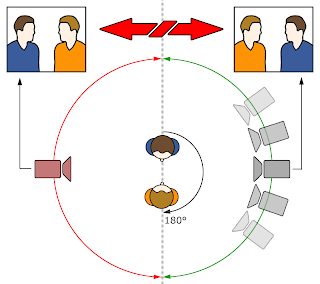
Camera Angle
There are different camera angles that can create and mean different things. This can cause the viewer to focus more or find it more interesting as it changes their view as it is different to what we see in real life as we often see things at eye height angles not low angles or high angles. Here are some of the different angles and what they usually mean…
High angle- a shot made pointing down on a character to make the character seem inferior.
Low angle- can make the character seem superior.
Ground level- makes the shot more interesting and can often make a scene seem to speed up as it can be a shot of someone running.
Diagonal line- can give a view of something that we don’t focus on straight away.
There are different camera angles that can create and mean different things. This can cause the viewer to focus more or find it more interesting as it changes their view as it is different to what we see in real life as we often see things at eye height angles not low angles or high angles. Here are some of the different angles and what they usually mean…
High angle- a shot made pointing down on a character to make the character seem inferior.
Low angle- can make the character seem superior.
Ground level- makes the shot more interesting and can often make a scene seem to speed up as it can be a shot of someone running.
Diagonal line- can give a view of something that we don’t focus on straight away.
Focus
Focus is about depth of field or shot, if you make things in focus that you want people to see then you focus on that particular thing focused and everything around it blurred or a tiny bit blurred. A deep focus is often when everything in shot is focused.
Continuity
Continuity of travel is when you keep the character moving out of the screen then coming on so it looks like they are walking through each shot so if they leave a shot from the right of the screen they then enter the next shot from the left of the screen.
Hierarchy of film production
Focus is about depth of field or shot, if you make things in focus that you want people to see then you focus on that particular thing focused and everything around it blurred or a tiny bit blurred. A deep focus is often when everything in shot is focused.
Continuity
Continuity of travel is when you keep the character moving out of the screen then coming on so it looks like they are walking through each shot so if they leave a shot from the right of the screen they then enter the next shot from the left of the screen.
Hierarchy of film production
8 Shot Journey
For our project we had to create a short film about some on going on a journey to some where and them getting their we had to have a range of still shots at different angles with different shot sizes, we also had to plan what we would do for filming, we did this by using story boards and as we filmed we had to do log sheets here they are…
For our project we had to create a short film about some on going on a journey to some where and them getting their we had to have a range of still shots at different angles with different shot sizes, we also had to plan what we would do for filming, we did this by using story boards and as we filmed we had to do log sheets here they are…
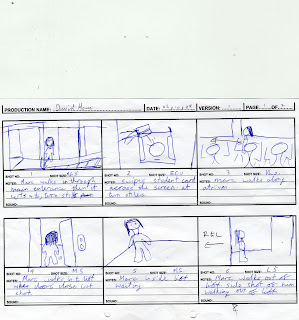
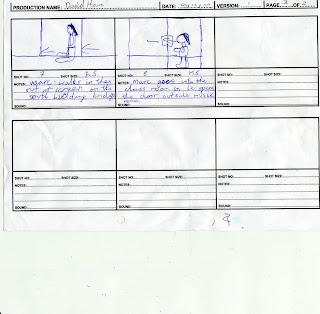
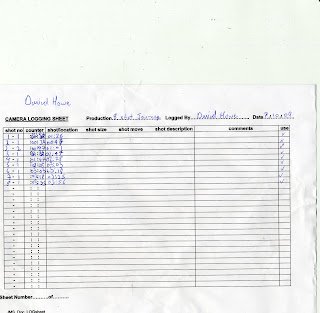
my 8 Shot Journey.. (watch in mute)
Tuesday, 20 October 2009
Radio Evaluation
Evaluation
Our task was to create 3 radio jingles for different shows on the SNC radio station these were:
· A News program intro.
· A personal show promo.
· Ident for SNC radio.
For me to do this task I firstly had to plan what sort of style my jingles would be. As it was for a college radio I decided to go for a radio 1 type of theme and have very modern but up to date music. I found this fairly easy as all I needed to do was record the music of the internet. After doing so I went to edit my music and add in speech. The program I used was on the apple Mac’s called Abode, Sound booth. I found this software fairly easy to use even though it had been my first time of using this type of program.
I made all of the three jingles that we were asked to do. Some of them I was happier with than others, one of them which were for the station ident as it was more creative in the vocals as I recorded lots of people saying the words “SNC Live”, in total I had about eight people talking on the recoding. I separated them out but put them into a flowing stream of voices that were both female and male to show that the station was not sexist, I then put a music track underneath but this has different up beat and lively tracks. One bad point was that it seemed to last a bit to long so the listeners could get bored.
The next jingle that I was happy about was the news jingle as I took a well know tune for the beginning of a news program and put an up beat track over the top to seem more appealing to the audience and to sound more modern also to discuss the well known title track but it seemed to not work and people realised what it was so if it was prod cast it would be seen as plagiarism.
The one jingle that I was least happy about was my program promo, this was because it was very long but also seemed too jumpy instead of flowing between the different tracks so their was sudden songs starting when other songs hadn’t finished so listeners could find it confusing.one good point about it was at the start I have an intro for people listening so that they can tell when it is starting and it catches the audiences attention as well.
Over all the software that I used for my project to edit these indents and create them was a very easy program to use as I was able to see all the tracks I was using and was able to edit them individually and then put them into a time line of tracks and see what ones I had over lapping or over the other tracks it also meant that I could easily adjust the volume levels of the different tracks to make them heard easily, I was also able to change how big the files where and their quality to make it easy for the listener to have a better quality with no interference.
Our task was to create 3 radio jingles for different shows on the SNC radio station these were:
· A News program intro.
· A personal show promo.
· Ident for SNC radio.
For me to do this task I firstly had to plan what sort of style my jingles would be. As it was for a college radio I decided to go for a radio 1 type of theme and have very modern but up to date music. I found this fairly easy as all I needed to do was record the music of the internet. After doing so I went to edit my music and add in speech. The program I used was on the apple Mac’s called Abode, Sound booth. I found this software fairly easy to use even though it had been my first time of using this type of program.
I made all of the three jingles that we were asked to do. Some of them I was happier with than others, one of them which were for the station ident as it was more creative in the vocals as I recorded lots of people saying the words “SNC Live”, in total I had about eight people talking on the recoding. I separated them out but put them into a flowing stream of voices that were both female and male to show that the station was not sexist, I then put a music track underneath but this has different up beat and lively tracks. One bad point was that it seemed to last a bit to long so the listeners could get bored.
The next jingle that I was happy about was the news jingle as I took a well know tune for the beginning of a news program and put an up beat track over the top to seem more appealing to the audience and to sound more modern also to discuss the well known title track but it seemed to not work and people realised what it was so if it was prod cast it would be seen as plagiarism.
The one jingle that I was least happy about was my program promo, this was because it was very long but also seemed too jumpy instead of flowing between the different tracks so their was sudden songs starting when other songs hadn’t finished so listeners could find it confusing.one good point about it was at the start I have an intro for people listening so that they can tell when it is starting and it catches the audiences attention as well.
Over all the software that I used for my project to edit these indents and create them was a very easy program to use as I was able to see all the tracks I was using and was able to edit them individually and then put them into a time line of tracks and see what ones I had over lapping or over the other tracks it also meant that I could easily adjust the volume levels of the different tracks to make them heard easily, I was also able to change how big the files where and their quality to make it easy for the listener to have a better quality with no interference.
Radio Production
Radio Jingles
Radio jingles are basically advertisements for different things or services available to people.
Radio shows contain jingles for a product such as “conservatories from SEH”, they also contain jingles for different shows on the station such as the “Chris moyels” show and they also can be used as a station ident so that people know which station they are listening to such as “heart fm”.
Radio jingles can also be used to advertise event’s that the station is doing but away from the studio or OB (outside booth), these events can be concerts or special one time events for example “radio 1`s big weekend”.
They can also be used to introduce a section of a show such as the news or a quiz.
When creating a jingle you have to think about two main points:
What is it for?
Who is it for?
For us to get an idea of how to do this we listened to two examples of jingles, the first was for radio one it was aimed at 13-25 and was to attract listeners, it was very techno and had sound effects also it was repetitive, bass`y and up beat. There was also a loud rhythm that was fast.
The second was for radio 2 it was aimed at an older generation of 25-60, it was upbeat long sing along and cheery.
Codes & conventions
Radio jingles
Speech has to be recognisable; sound effects have to be appropriate to the target audience. The music should recognisable/appropriate to the theme and must identify with the stations genre.
For a show promo- name of presenter
- idea of what the show is about
- time of the show is on and what frequency its on
- use high lights of who the presenters are
Task
Produce 3 jingles-:
1) news
2) promotion for your show
3) station ident for SNC radio
Script ideas
News- “SNC radio news is live in 5,4,3,2,1” music in the background maybe the news intro for news 24 or something like it then the start of the news “this afternoon…”.
Show promo- “The David Howe show” (music mix) “SNC radio, the David Howe show” (music mix) “the latest music from the biggest college radio” fade out.
Station ident- “SNC live” said by different people with different parts of music song put underneath the track of people talking.
These where ideas and when producing these jingles I ended up not using all of these ideas as you will hear from the finished tracks…….
DJH-show-promo
news
SNC ident
Radio jingles are basically advertisements for different things or services available to people.
Radio shows contain jingles for a product such as “conservatories from SEH”, they also contain jingles for different shows on the station such as the “Chris moyels” show and they also can be used as a station ident so that people know which station they are listening to such as “heart fm”.
Radio jingles can also be used to advertise event’s that the station is doing but away from the studio or OB (outside booth), these events can be concerts or special one time events for example “radio 1`s big weekend”.
They can also be used to introduce a section of a show such as the news or a quiz.
When creating a jingle you have to think about two main points:
What is it for?
Who is it for?
For us to get an idea of how to do this we listened to two examples of jingles, the first was for radio one it was aimed at 13-25 and was to attract listeners, it was very techno and had sound effects also it was repetitive, bass`y and up beat. There was also a loud rhythm that was fast.
The second was for radio 2 it was aimed at an older generation of 25-60, it was upbeat long sing along and cheery.
Codes & conventions
Radio jingles
Speech has to be recognisable; sound effects have to be appropriate to the target audience. The music should recognisable/appropriate to the theme and must identify with the stations genre.
For a show promo- name of presenter
- idea of what the show is about
- time of the show is on and what frequency its on
- use high lights of who the presenters are
Task
Produce 3 jingles-:
1) news
2) promotion for your show
3) station ident for SNC radio
Script ideas
News- “SNC radio news is live in 5,4,3,2,1” music in the background maybe the news intro for news 24 or something like it then the start of the news “this afternoon…”.
Show promo- “The David Howe show” (music mix) “SNC radio, the David Howe show” (music mix) “the latest music from the biggest college radio” fade out.
Station ident- “SNC live” said by different people with different parts of music song put underneath the track of people talking.
These where ideas and when producing these jingles I ended up not using all of these ideas as you will hear from the finished tracks…….
DJH-show-promo
news
SNC ident
pictures
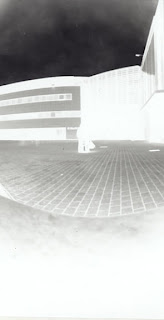
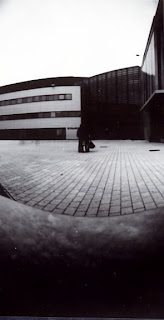 These two pictures are my best pictures taken out side of the front of SNC campus.the picture on the left is the original that it took with my pin hole camera it took 10 seconds for me to get the right light exposure, however i took a number of pictures before that all had either to much light or too little light exposure.the times that i went through where 15 seconds, 10 seconds and 5 seconds until i realised that it could be the top was letting light in. the picture on the right has been inverted on photo shop to take out the negative parts in the photo and to make it look more life like.
These two pictures are my best pictures taken out side of the front of SNC campus.the picture on the left is the original that it took with my pin hole camera it took 10 seconds for me to get the right light exposure, however i took a number of pictures before that all had either to much light or too little light exposure.the times that i went through where 15 seconds, 10 seconds and 5 seconds until i realised that it could be the top was letting light in. the picture on the right has been inverted on photo shop to take out the negative parts in the photo and to make it look more life like.these pictures are of the atrium in side the college as you can see the light exposure was just enough, however this was the last picture i took of the atruim, the one before is below but as you can see their is too much light exposure so it is very dark as the shutter was up for too long. i took the first pic for 35 minuets but i took the second for 15 minuets and i was not sure how it would come out as i was near lights so their was a possibility of too much light.i then inverted the oringinals after scanning them to the computer.
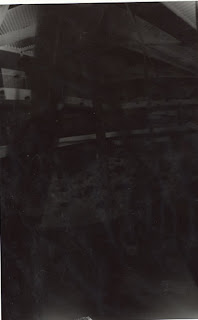
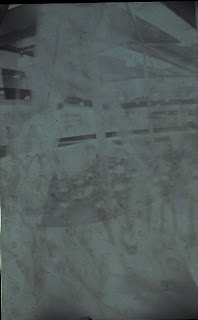
Thursday, 15 October 2009
Pin hole photograhpy.
Photography
Photography is the process or activity and art of creating still or moving images, by reading radiation on a sensitive medium (photographic paper) or an electronic sensor. Light patterns reflected or emitted from objects activate a sensitive chemical or electronic sensor during a timed exposure, usually through a photographic lens in a device known as a camera that also stores the resulting information chemically or electronically. Photography has many uses for business, science, art and pleasure.
Genres of photography
· Aerial
· Black and white
· Commercial
· Documentary
· Fashion
· Fine art
· Forensic
· Glamour
· High speed
· Illustration
· Landscape
· Nature
· Pap
· Photo journalism
There are still many other genres…….
Some examples of these genres:
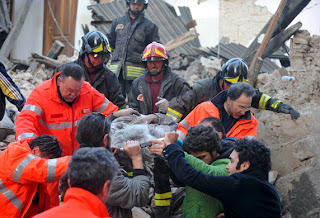 Documentary
Documentary
It is a documentary photo as it has actually happened.
It’s of a disaster. There are people in natural movement. Loads of people.
Photography is the process or activity and art of creating still or moving images, by reading radiation on a sensitive medium (photographic paper) or an electronic sensor. Light patterns reflected or emitted from objects activate a sensitive chemical or electronic sensor during a timed exposure, usually through a photographic lens in a device known as a camera that also stores the resulting information chemically or electronically. Photography has many uses for business, science, art and pleasure.
Genres of photography
· Aerial
· Black and white
· Commercial
· Documentary
· Fashion
· Fine art
· Forensic
· Glamour
· High speed
· Illustration
· Landscape
· Nature
· Pap
· Photo journalism
There are still many other genres…….
Some examples of these genres:
 Documentary
DocumentaryIt is a documentary photo as it has actually happened.
It’s of a disaster. There are people in natural movement. Loads of people.
Fashion 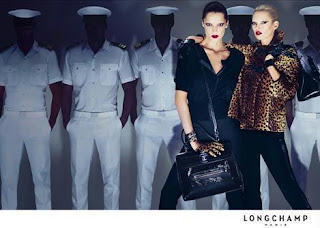
It is of a clothing designer and they are in a fashioned pose.
The models are standing out. It tells us that they are in a fashion run way.
If u buys this product it suggests that you will be gorgeous.

It is of a clothing designer and they are in a fashioned pose.
The models are standing out. It tells us that they are in a fashion run way.
If u buys this product it suggests that you will be gorgeous.
Portrait 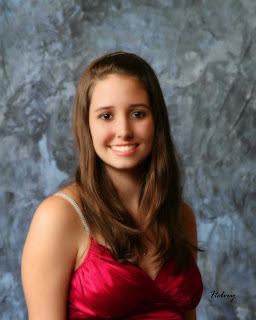
The person is facing he camera in a portrait pose and it is of one single person. She is serious. It shows her facial features.

The person is facing he camera in a portrait pose and it is of one single person. She is serious. It shows her facial features.
The pin hole camera
Camera
It is a device that records images, either as a still photograph or as a moving image known as a video or movie. The term camera from the camera obscura (Latin for “dark room”), an early mechanism of projecting images where an entire room functioned as a real-time imaging system; the modern camera evolved from the camera obsuura.
Shutter
In photography, a shutter is a device that allows light to pass for a determined period of time, for the purpose of exposing photographic film or a light-sensitive electronic sensor to light to capture as permanent image of a scene.
Aperture
In optics, an aperture is a hole or an opening through which light travels. In pin hole photography this is often a hole made by a pin so the hole is fairly small.
Lens
The lens of a camera captures the light from the subject and brings it to a focus on the film or detector.
Exposure control
The size of the aperture and the brightness of the scene controls the amount of the light that enters the camera during a period of time, and the shutter controls the length of time that the light hits the recording surface. Equivalent exposures can be made with a larger aperture and a faster shutter speed or a corresponding smaller aperture and with the shutter speed slowed down.
Links
http://www.flickr.com/groups/pinholes/
http://www. Pinholeformat.com/gallery.html
http://www.lenoxluser.com/pinholephotos/
It is a device that records images, either as a still photograph or as a moving image known as a video or movie. The term camera from the camera obscura (Latin for “dark room”), an early mechanism of projecting images where an entire room functioned as a real-time imaging system; the modern camera evolved from the camera obsuura.
Shutter
In photography, a shutter is a device that allows light to pass for a determined period of time, for the purpose of exposing photographic film or a light-sensitive electronic sensor to light to capture as permanent image of a scene.
Aperture
In optics, an aperture is a hole or an opening through which light travels. In pin hole photography this is often a hole made by a pin so the hole is fairly small.
Lens
The lens of a camera captures the light from the subject and brings it to a focus on the film or detector.
Exposure control
The size of the aperture and the brightness of the scene controls the amount of the light that enters the camera during a period of time, and the shutter controls the length of time that the light hits the recording surface. Equivalent exposures can be made with a larger aperture and a faster shutter speed or a corresponding smaller aperture and with the shutter speed slowed down.
Links
http://www.flickr.com/groups/pinholes/
http://www. Pinholeformat.com/gallery.html
http://www.lenoxluser.com/pinholephotos/
Subscribe to:
Comments (Atom)





